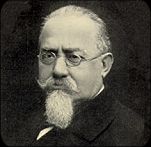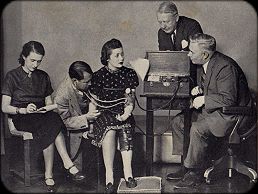
 |
|
 |
|
 |
|
|
|
 |
![]()
|
|
||
 The
idea that lying produces physical side-effects has long been
claimed. In West Africa persons suspected of a crime were
made to pass a bird's egg to one another. If a person broke
the egg, then he or she was considered guilty, based on the
idea that their nervousness was to blame. In ancient China
the suspect held a handful of rice in his or her mouth
during a prosecutor's speech. Because salivation was
believed to cease at times of emotional anxiety, the person
was considered guilty if by the end of that speech the rice
was dry. The
idea that lying produces physical side-effects has long been
claimed. In West Africa persons suspected of a crime were
made to pass a bird's egg to one another. If a person broke
the egg, then he or she was considered guilty, based on the
idea that their nervousness was to blame. In ancient China
the suspect held a handful of rice in his or her mouth
during a prosecutor's speech. Because salivation was
believed to cease at times of emotional anxiety, the person
was considered guilty if by the end of that speech the rice
was dry.Early devices for lie detection include an 1885 invention of Cesare Lombroso used to measure changes in blood pressure for police cases, a 1904 device by Vittorio Benussi used to measure breathing, and an abandoned project by American William Marston which used blood pressure and galvanic skin response to examine German prisoners of war (POWs). Sir James Mackenzie of Scone, Scotland invented an early lie detector or polygraph in the 1900s. MacKenzie's polygraph "could be used to monitor the cardiovascular responses of his patients by taking their pulse and blood pressure. He had developed an early version of his device in the 1890s, but had Sebastian Shaw, a Lancashire watchmaker, improve it further. "This instrument used a clockwork mechanism for the paper-rolling and time-marker movements and it produced ink recordings of physiological functions that were easier to acquire and to interpret. Interestingly, it has been written that the modern polygraph is really a modification of Dr. Mackenzie's clinical ink polygraph." A device recording both blood pressure and galvanic skin response was invented in 1911 by Dr. Reginald A. Larson of the University of California and first applied in law enforcement work by the Berkeley Police Department under its nationally renowned police chief August Vollmer. Further work on this device was done by Leonarde Keeler. Several devices similar to Keeler's polygraph version included the Berkeley Psychograph, a blood pressure-pulse-respiration recorder developed by C. D. Lee in 1936 and the Darrow Behavior Research Photopolygraph, which was developed and intended solely for behavior research experiments.  Marston
wrote a second paper on the concept in 1915, when finishing
his undergraduate studies. He entered Harvard Law School and
graduated in 1918, re-publishing his earlier work in 1917.
According to their son, Marston's wife, Elizabeth Holloway
Marston, was also involved in the development of the
systolic blood pressure test: "According to Marston’s son,
it was his mother Elizabeth, Marston’s wife, who suggested
to him that 'When she got mad or excited, her blood pressure
seemed to climb' (Lamb, 2001). Although Elizabeth is not
listed as Marston’s collaborator in his early work, Lamb,
Matte (1996), and others refer directly and indirectly to
Elizabeth’s work on her husband’s deception research. She
also appears in a picture taken in his polygraph laboratory
in the 1920s (reproduced in Marston, 1938)." The comic book
character, Wonder Woman, by William Marston (and influenced
by Elizabeth Marston) carries a magic lasso which was
modelled upon the pneumograph (breathing monitor) test. Marston
wrote a second paper on the concept in 1915, when finishing
his undergraduate studies. He entered Harvard Law School and
graduated in 1918, re-publishing his earlier work in 1917.
According to their son, Marston's wife, Elizabeth Holloway
Marston, was also involved in the development of the
systolic blood pressure test: "According to Marston’s son,
it was his mother Elizabeth, Marston’s wife, who suggested
to him that 'When she got mad or excited, her blood pressure
seemed to climb' (Lamb, 2001). Although Elizabeth is not
listed as Marston’s collaborator in his early work, Lamb,
Matte (1996), and others refer directly and indirectly to
Elizabeth’s work on her husband’s deception research. She
also appears in a picture taken in his polygraph laboratory
in the 1920s (reproduced in Marston, 1938)." The comic book
character, Wonder Woman, by William Marston (and influenced
by Elizabeth Marston) carries a magic lasso which was
modelled upon the pneumograph (breathing monitor) test. Marston was the self-proclaimed “father of the polygraph” despite his predecessor's contributions. Marston remained the device's primary advocate, lobbying for its use in the courts. In 1938 he published a book, The Lie Detector Test, wherein he documented the theory and use of the device. In 1938 he appeared in advertising by the Gillette company claiming that the polygraph showed Gillette razors were better than the competition. A device which recorded muscular activity accompanying changes in blood pressure was developed in 1945 by John E. Reid, who claimed that greater accuracy could be obtained by making these recordings simultaneously with standard blood pressure-pulse-respiration recordings. Since then the field of lie detection has evolved significantly, with modern polygraph devices measuring blood pressure, pulse, respiration, breathing rhythms, body temperature and skin conductivity to detect lying.  More
modern techniques like brain scans could provide even more
accurate methods to root out a lie. Researchers announced
last year that brain scans of people telling the truth look
very different from those who are lying. This technique is
however prohibitively expensive, and more traditional
polygraph tests are typically what is used in South Africa
to sniff out the likes of fraudsters, con men and unfaithful
spouses. More
modern techniques like brain scans could provide even more
accurate methods to root out a lie. Researchers announced
last year that brain scans of people telling the truth look
very different from those who are lying. This technique is
however prohibitively expensive, and more traditional
polygraph tests are typically what is used in South Africa
to sniff out the likes of fraudsters, con men and unfaithful
spouses.Accuracy Polygraph test results remain inadmissible in South African courts. Similarly in most European jurisdictions polygraph tests are not considered reliable evidence and are not generally used by police forces. Polygraph results however remain popular as forensic tools in criminal investigations and are extensively used in security agencies (like the CIA and SA’s NIA). Nico Jooste, MD of Polygraph Technologies and a former intelligence polygraph expert says that there is currently nothing available to mankind with which the truth can be established that is more reliable. “In the past 40 years more than 250 studies have been conducted by research institutions worldwide, and the results of these indicate a reliability rate of more than 80%,” says Nico Jooste. “With one of the best instruments available, the correct question technique and a well trained, experienced examiner, results of up to 98% can be achieved.” |
||
|
|
|
|
This site can be viewed at almost any resolution Copyright © ZAbra.co.za August 2010 |